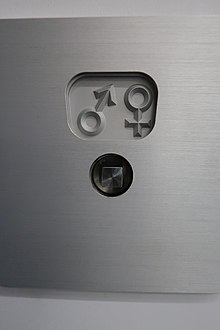
Back رمز النوع الاجتماعي Arabic Символи на пола Bulgarian Símbol de gènere Catalan Genderový symbol Czech Gender-Symbol German Símbolo de género Spanish نماد جنسیت Persian Sukupuolen symboli Finnish Symbole de genre French Seksesymboal Frisian

A gender symbol is a pictogram or glyph used to represent sex and gender, for example in biology and medicine, in genealogy, or in the sociological fields of gender politics, LGBT subculture and identity politics.
In his books Mantissa Plantarum (1767) and Mantissa Plantarum Altera (1771), Carl Linnaeus regularly used the planetary symbols of Mars, Venus and Mercury – ♂, ♀, ☿ – for male, female and hermaphroditic (perfect) flowers, respectively.[1] Botanists now use ⚥ for the last.[2]
In genealogy, including kinship in anthropology and pedigrees in animal husbandry, the geometric shapes △ or □ are used for male and ○ for female. These are also used on public toilets in some countries.
The modern international pictograms used to indicate male and female public toilets, 🚹︎ and 🚺︎, became widely used in the 1960s and 1970s. They are sometimes abstracted to ▽ for male and △ for female.[3]
- ^ Stearn, William T. (May 1962). "The Origin of the Male and Female Symbols of Biology". Taxon. 11 (4): 109–113. doi:10.2307/1217734. JSTOR 1217734. S2CID 87030547.
- ^ Niki Simpson, Botanical symbols: a new symbol set for new images, Botanical Journal of the Linnean Society, Volume 162, Issue 2, February 2010, Pages 117–129
- ^ Glancey, Jonathan (11 September 2014). "The genius behind the stick figure toilet signs". BBC Future.
In Poland, meanwhile, you can come across lavatories indicating 'gents' with a triangle and 'ladies' with a circle, while in Lithuania men are represented by an inverted pyramid and women by a pyramid standing the right way up. [...] One of the best early examples of intuitive global signs for public lavatories was that created for British Rail in the mid-1960s. [...] In the 1970s, the British example was developed on a more comprehensive basis in the United States. In 1974, the US Department of Transportation commissioned the American Institute of Graphic Arts to create a set of pictograms to be used throughout public transport networks whether road, rail, air or sea.